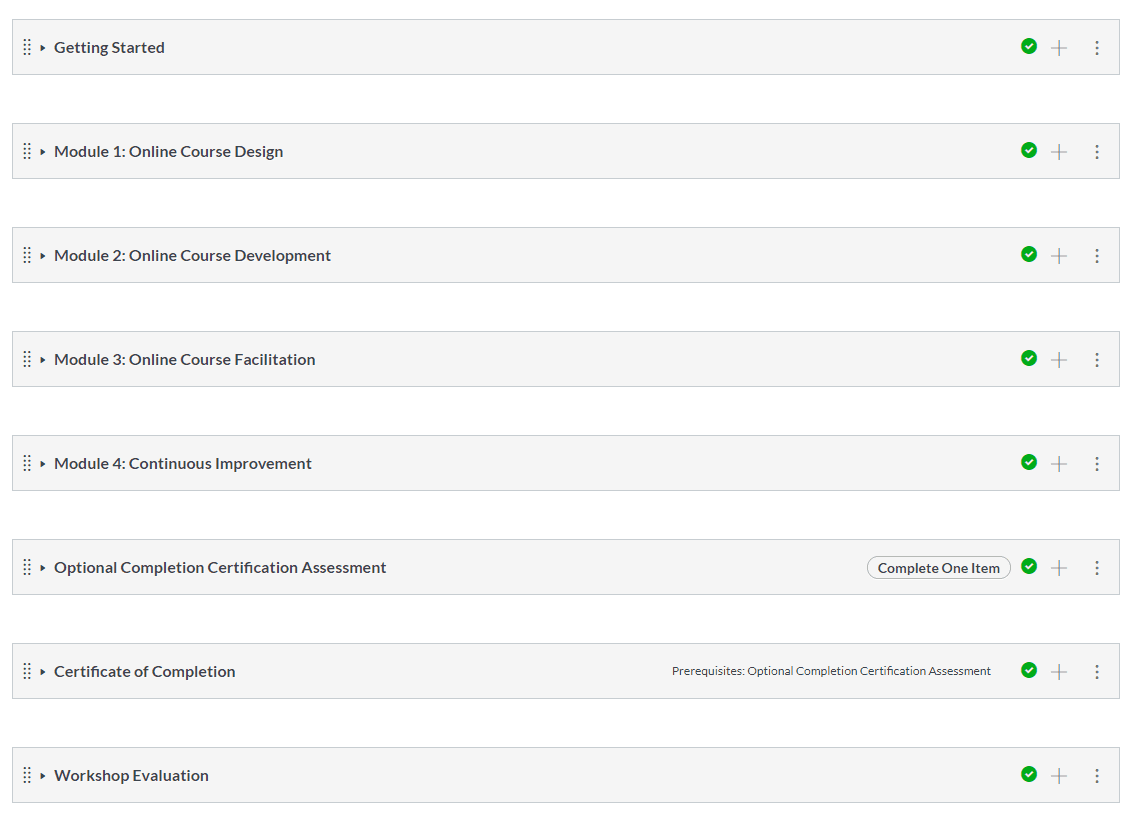Chunking and Pacing in Online Courses
Chunking content is important in any learning environment. It allows students to engage with information in smaller, meaningful sections. We don’t want to cognitively overwhelm or overload students. As you design your course, carefully consider the best way to chunk the material. Many online instructors breakdown course content into weekly modules. If you have a course textbook, these modules may align with chapters from the book.
The example below has been chunked into modules. A Getting Started Module provides an overview of the course. Module 1 contains information related to course design. Topics related to course development are grouped to form module two. Content related to course facilitation can be found in module three. The final module addresses continuous improvement.

Each module is further broken down into several pages. Each page contains specific content related to one topic addressed in the learning module. Again, the purpose of chunking is to create manageable pieces of content.
Chunking Page Content
As you develop pages, it is important to chunk information. This can be accomplished through the use of:
- Headings
- Subheadings
- Short paragraphs
- Bold fonts
- Bullets
- Images
- Spacing
Pacing
The pace of your course is an important aspect in promoting student success. It should not feel too slow for students, resulting in boredom and decreased motivation. Likewise, it should not be too fast, leaving students feeling anxious and overwhelmed. In a traditional course, you read the expressions on students’ faces to determine when you need to speed up or slow down. You do not have that advantage in an online course.
Content, activities, and assessments will comprise your learning modules. Set a realistic goal for how much work can be completed in a week. Remember you are an expert in this area, your students are still developing their skills and may take longer than expected to complete activities. Also, remember additional time is needed to read responses and use technology tools.
Consider using a visual tool, such as a calendar, to help pace the course. Write in due dates for activities and assessments. If there is too much overlap or too heavy of a work load, students will not be able to devote adequate time to each assignment. In addition, think about your role as the instructor. Will you be able to provide timely and specific feedback for all work?
Best practice in online course delivery is to have the entire class completed at the beginning of the semester. This way students can see a big picture view of what they will be learning and can better plan for heavy weeks during the semester.
If you’re not able to have the course 100% completed, you’ll need to determine when modules will open for students to view. Keep this day consistent throughout the semester. If each new module opens on a Monday, with assignments due on Sunday, make sure you are available on the weekends to answer questions. If that schedule presents problems, consider opening new modules each Wednesday and having assignments due the following Tuesday. Students count on being able to work at a steady pace and depend on your consistency and availability.